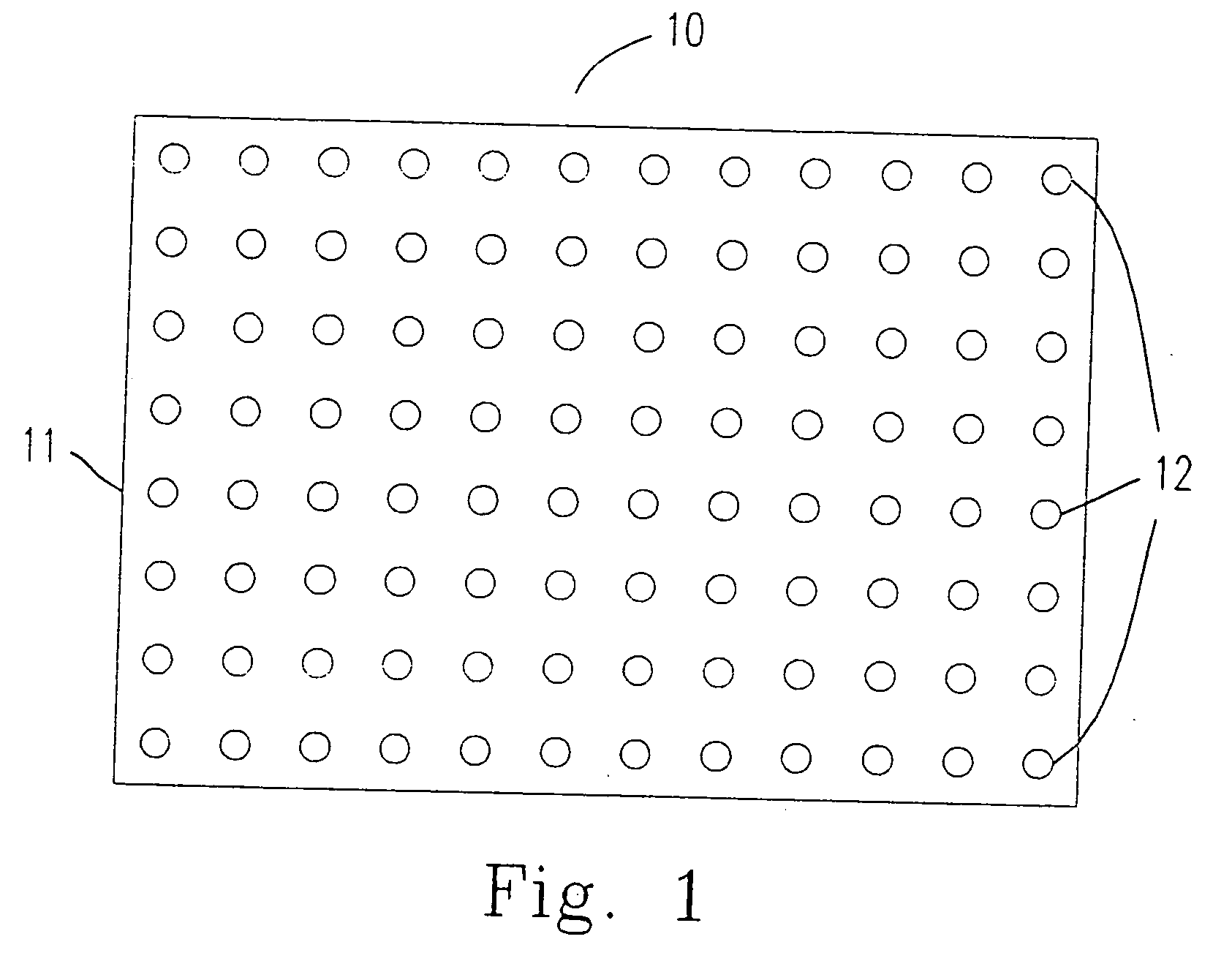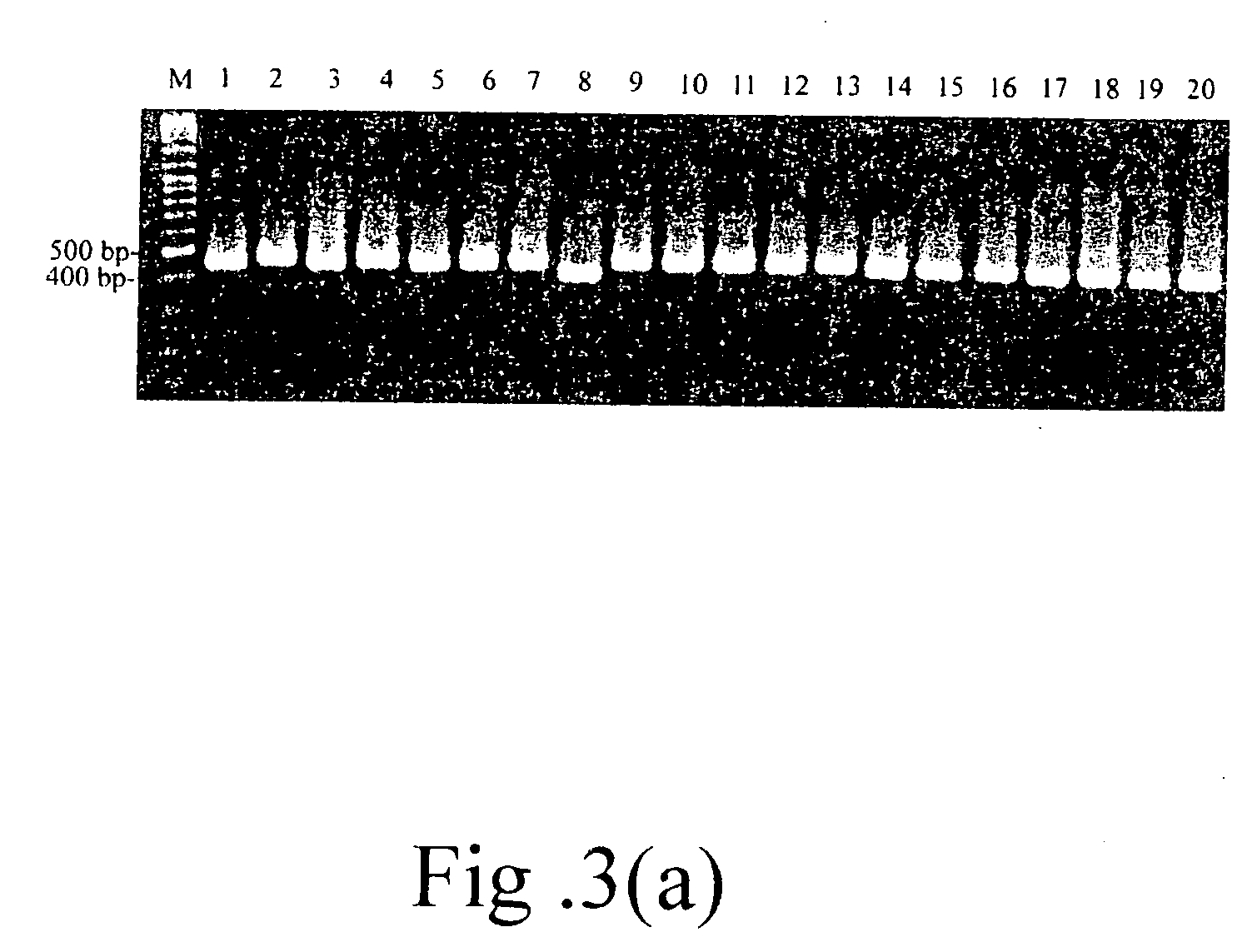Method and detector for identifying subtypes of human papilloma viruses
a detection method and human papilloma virus technology, applied in the field of human papilloma virus detection methods and detectors, can solve the problems of serious affecting diagnosis accuracy, inability to identify clinically important subtypes of human papilloma viruses contained in specimens, and inability to detect the conventional hpv detection kits without system control for checking house-keeping genes. , the effect of rapid and reliable detection and identification
- Summary
- Abstract
- Description
- Claims
- Application Information
AI Technical Summary
Benefits of technology
Problems solved by technology
Method used
Image
Examples
example i
[0058] The method for immobilizing or mounting the above mentioned probes (oligonucleotides) on the carrier 11 (the nylon membrane) is described as follows.
[0059] 1.-TTTTTTTTTTTTTTT (SEQ ID NO 469) is added to the 3′ end of the oligonucleotide provided by the present invention by terminal transferase according to the following steps 1.1 to 1.3.
[0060] 1.1 Mixing the following components:
10X NEBuffer 45μl2.5 mM CoCl25μloligonucleotide5˜300pmol10˜300 mM dATP, dCTP, dTTP or dGTP1μlTerminal Transferase (20 U / μl)0.5˜5μl(NEW English BioLabs, M0252S)Add M.Q. H2O to final volume50μl
[0061] 1.2 The components are mixed at 37° C. for 15-60 minutes.
[0062] 1.3 10 μl of 0.2 M EDTA (pH 8.0) is added to the mixture to stop the reaction.
[0063] 2. The oligonucleotide having 3′ end labeling is mounted on the carrier 11 according to the following steps 2.1 to 2.3.
[0064] 2.1 The oligonucleotide having 3′ end labeling is mounted on the carrier 11 by a needle having a 400 μm wide head. The distance ...
example ii
[0067] According to another preferred embodiment of the present invention, the carrier 11 could be a glass plate. The method for immobilizing or mounting the above mentioned probes (oligonucleotides) on the carrier 11 (glass plate) is described as follows.
[0068] 1. The surface of the carrier 11 is treated according to the following steps 1.1 to 1.8.
[0069] 1.1 The carrier 11 is cleaned in non-fluorescent and soft cleaner.
[0070] 1.2 The clean carrier 11 is immersed in 10% NaOH.
[0071] 1.3 The carrier 11 is oscillated in double-distilled water, 1% HCl solution and methanol in sequence for 2 minutes, and dried in an oven.
[0072] 1.4 The carrier 11 is immersed in 1% 3-aminopropyltrimethoxysilane (APTMS) in 95% aqueous acetone at room temperature for about 2 minutes.
[0073] 1.5 The carrier 11 is washed in acetone, and the carrier 11 is dried in the oven at 110° C. for 45 minutes.
[0074] 1.6 The dried carrier 11 is immersed in 0.2% 1,4-phenylene diisothiocyanate, wherein the solvent is ...
example iii
[0085] 1. The biological sample obtained from the patient is treated according to the following steps 1.1 to 1.3.
[0086] 1.1 The cells are centrifuged at 1,500 rpm at 200□ for 5 minutes.
[0087] 1.2 The cell pellet is washed in 10 mM Tris (pH 8.5) and dissolved in 8 mM NaOH. Then, the solution is transfer to 1.5 mL micro-tube.
[0088] 1.3 A proper amount of TreTaq (1U / μl) solution is added to the micro-tube. The reaction is carried out at 95□ for 1 hour. The DNA contained in the sample is obtained after centrifugation at 13,500 rpm, 20□ for 5 minutes. The obtained DNA is preserved at −20□.
PUM
| Property | Measurement | Unit |
|---|---|---|
| distance | aaaaa | aaaaa |
| width | aaaaa | aaaaa |
| width | aaaaa | aaaaa |
Abstract
Description
Claims
Application Information
 Login to View More
Login to View More - R&D
- Intellectual Property
- Life Sciences
- Materials
- Tech Scout
- Unparalleled Data Quality
- Higher Quality Content
- 60% Fewer Hallucinations
Browse by: Latest US Patents, China's latest patents, Technical Efficacy Thesaurus, Application Domain, Technology Topic, Popular Technical Reports.
© 2025 PatSnap. All rights reserved.Legal|Privacy policy|Modern Slavery Act Transparency Statement|Sitemap|About US| Contact US: help@patsnap.com



